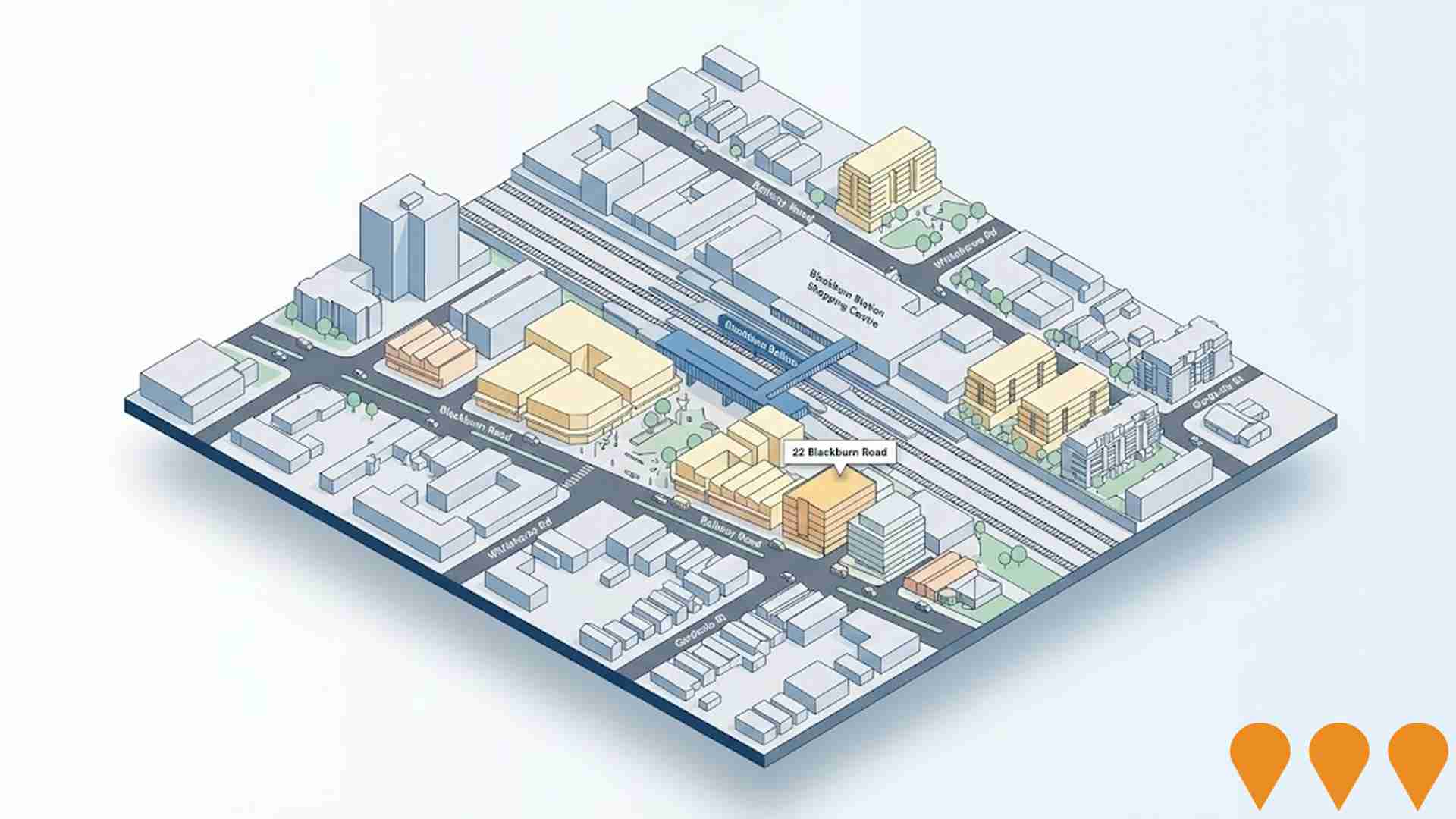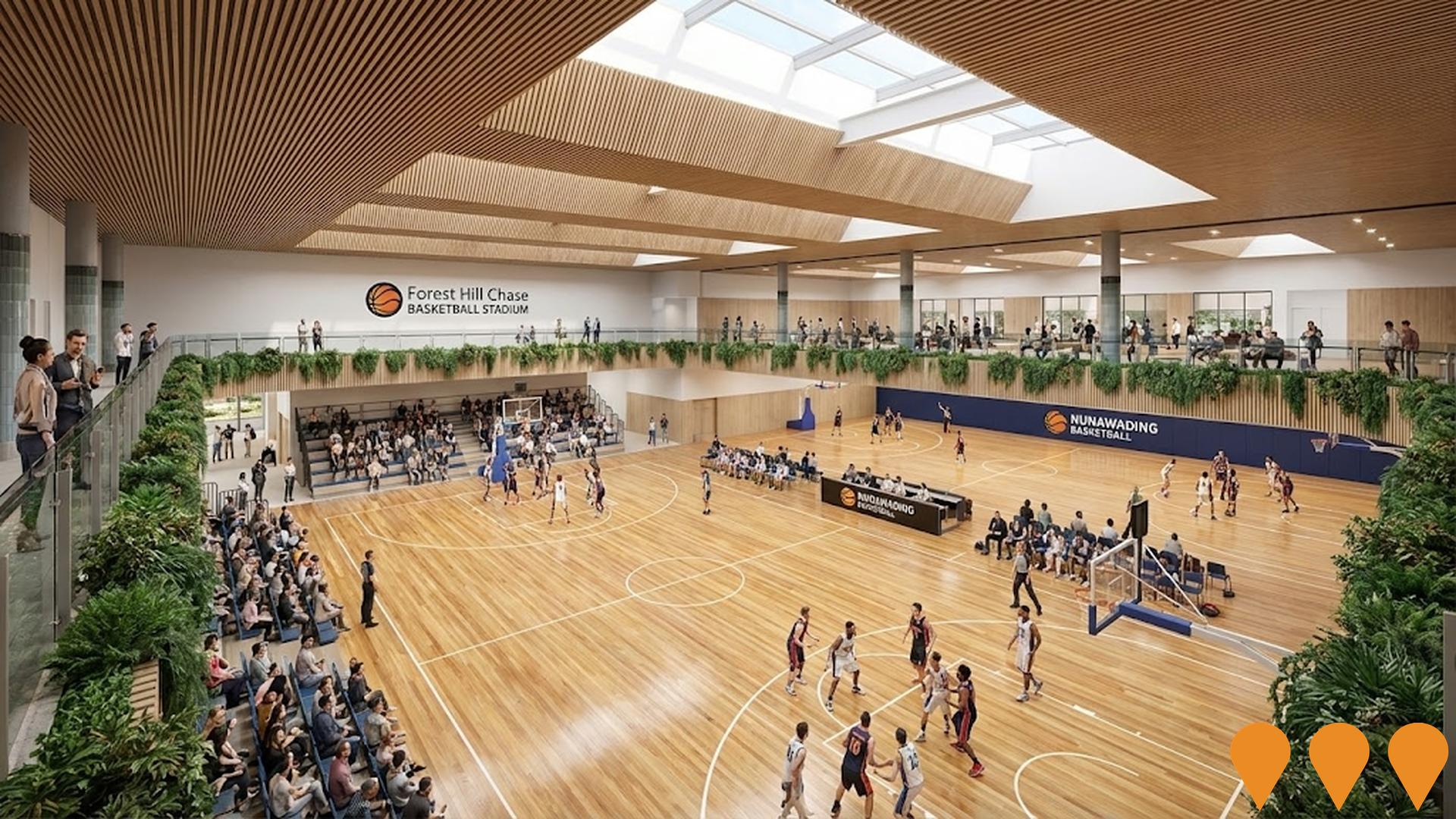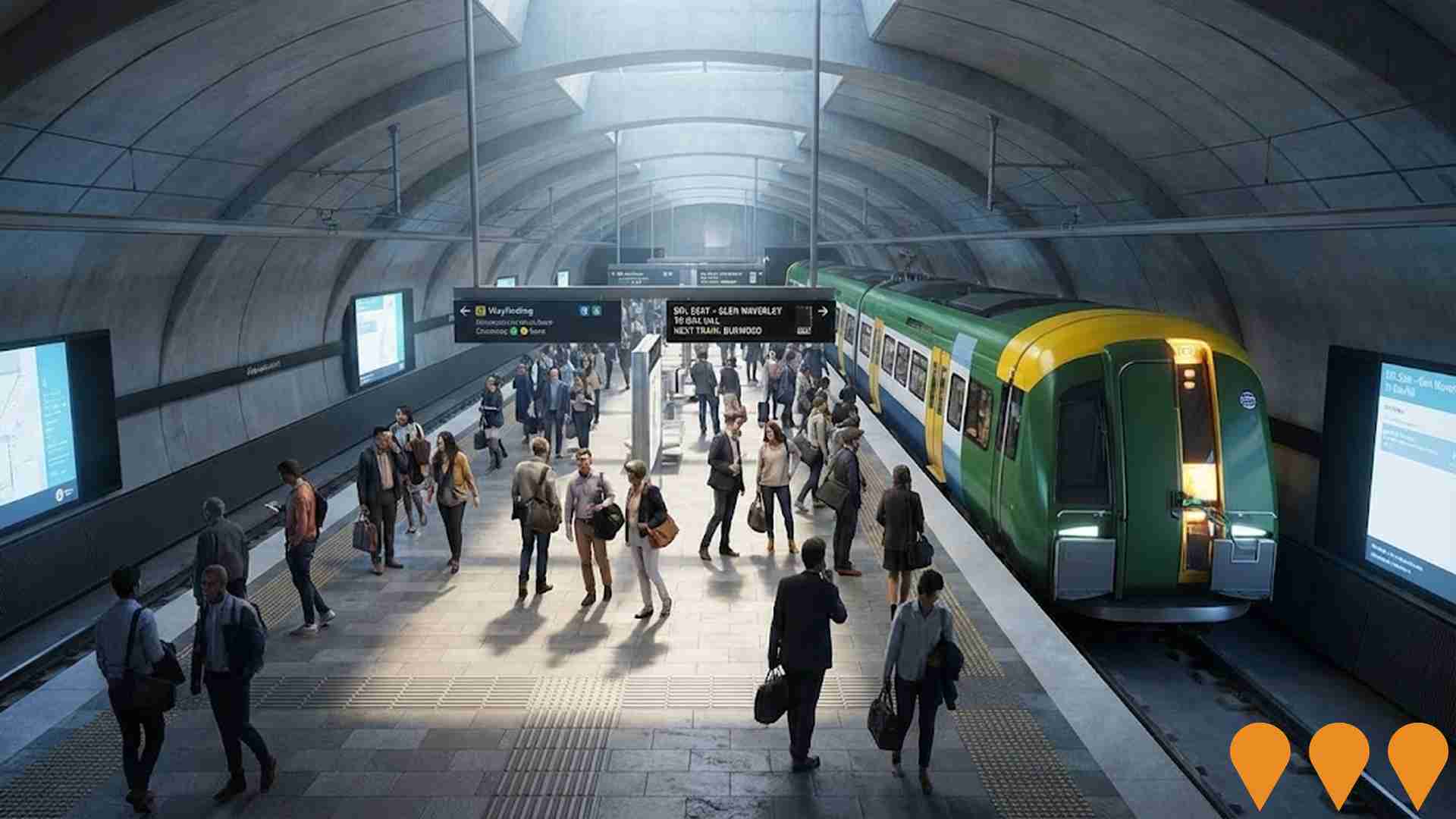Chart Color Schemes
est. as @ -- *
ABS ERP | -- people | --
2021 Census | -- people
Sales Activity
Curious about local property values? Filter the chart to assess the volume and appreciation (including resales) trends and regional comparisons, or scroll to the map below view this information at an individual property level.
Find a Recent Sale
Sales Detail
Population
Blackburn South is positioned among the lower quartile of areas assessed nationally for population growth based on AreaSearch's assessment of recent, and medium term trends
Blackburn South's population, as of Aug 2025, is approximately 11,079. This figure represents a growth of 140 people since the 2021 Census, which recorded a population of 10,939. The increase is inferred from ABS data showing an estimated resident population of 11,081 as of June 2024 and additional validated new addresses since the Census date. This results in a population density ratio of 3,077 persons per square kilometer, placing Blackburn South in the upper quartile nationally according to AreaSearch's assessments. Overseas migration was the primary driver of population growth in recent periods.
AreaSearch uses ABS/Geoscience Australia projections for each SA2 area released in 2024 with a base year of 2022. For areas not covered by this data, AreaSearch employs VIC State Government's Regional/LGA projections from 2023, adjusting using weighted aggregation methods to SA2 levels. Growth rates by age group are applied across all areas for the years 2032 to 2041. By 2041, Blackburn South is projected to grow by 424 persons based on current demographic trends, representing a total increase of approximately 3.8%.
Frequently Asked Questions - Population
Development
Residential development activity is lower than average in Blackburn South according to AreaSearch's national comparison of local real estate markets
Blackburn South recorded approximately 44 residential properties granted approval annually over the past five financial years ending June 2021, totalling 224 homes. As of August 2026, six approvals have been recorded in FY-26. The population has declined recently, with new supply likely meeting demand and offering good choice to buyers. New homes are being built at an average expected construction cost value of $703,000, indicating developers target the premium market segment with higher-end properties.
This financial year, $2.2 million in commercial approvals have been registered, reflecting the area's residential nature. Compared to Greater Melbourne, Blackburn South has markedly lower building activity (53.0% below regional average per person), which typically reinforces demand and pricing for existing dwellings. New building activity comprises 73.0% standalone homes and 27.0% townhouses or apartments, maintaining the area's traditional suburban character focused on family homes appealing to those seeking space. Blackburn South reflects a low density area with around 304 people per approval.
Looking ahead, Blackburn South is projected to grow by 424 residents by 2041. At current development rates, new housing supply should comfortably meet demand, providing good conditions for buyers and potentially supporting growth beyond current population projections.
Frequently Asked Questions - Development
Infrastructure
Blackburn South has strong levels of nearby infrastructure activity, ranking in the top 30% nationally
Changes to local infrastructure significantly influence an area's performance. AreaSearch has identified 14 projects that could impact this area. Notable projects include Blackburn South Exclusive Townhouse Collection, Mirrabooka Reserve Pavilion Redevelopment, Wurundjeri Walk Master Plan, and Raleigh Street Road Reconstruction Renewal Program. The following list details those likely to be most relevant.
Professional plan users can use the search below to filter and access additional projects.
INFRASTRUCTURE SEARCH
 Denotes AI-based impression for illustrative purposes only, not to be taken as definitive under any circumstances. Please follow links and conduct other investigations from the project's source for actual imagery. Developers and project owners wishing us to use original imagery please Contact Us and we will do so.
Denotes AI-based impression for illustrative purposes only, not to be taken as definitive under any circumstances. Please follow links and conduct other investigations from the project's source for actual imagery. Developers and project owners wishing us to use original imagery please Contact Us and we will do so.
Frequently Asked Questions - Infrastructure
City Park
Multi-billion dollar mixed-use precinct comprising more than 50,000 sqm of retail, sports, entertainment, food and beverage, childcare, gyms, healthcare, wellness services, and technology HQ. It includes a convention centre and two hotels with over 400 keys, expected to generate over 10,000 jobs. The project received planning approval in May 2023 for the masterplan, and the first stage commercial office space was approved in 2021. However, the developer APH Holding entered **Voluntary Administration** in December 2024, which puts the future of the multi-billion dollar project in doubt.

Blackburn Activity Centre
Blackburn Activity Centre is designated under Victoria's Activity Centres Program as a neighbourhood activity centre focused on transit-oriented development around Blackburn railway station. The centre is guided by the Whitehorse City Council's Blackburn Activity Centre Structure Plan (adopted 2018, currently under review). It supports mixed-use development, increased housing density near public transport, improved public realm, and local employment opportunities.

Forest Hill Chase Basketball Stadium
A competition-grade three-court basketball stadium on Level 3 of Forest Hill Chase Shopping Centre, developed as Melbourne's first in-centre basketball facility. The stadium features training areas, competitive courts, and community spaces, providing a hub for recreational and aspiring professional players. This first-of-its-kind facility in the region blends sports with retail and entertainment to promote health, well-being, and youth development in partnership with Nunawading Basketball and Basketball Victoria.

SRL East - Works Package F - Stations - Glen Waverley to Box Hill
SRL East is a 26 km twin-tunnel orbital metro from Cheltenham to Box Hill with six new underground stations. Works Package F will deliver the three northern stations and associated precinct works at Glen Waverley, Burwood and Box Hill. Early works are underway across all SRL East station sites, with the shortlist for the stations contracts announced and award of the Glen Waverley to Box Hill stations package targeted for 2026. Trains are planned to commence passenger services in 2035.

Blackburn Road Level Crossing Removal
The project involved removing the dangerous level crossing at Blackburn Road by lowering the rail line underneath the road, enhancing Blackburn Station for better integration with the local village, adding new pedestrian and cycling paths between Blackburn and Nunawading, and improving safety and traffic flow for motorists, pedestrians, and cyclists. The road reopened in February 2017.

Wurundjeri Walk Master Plan
A comprehensive master plan for the connected reserves of Mirrabooka, Orchard Grove, and Fulton in Blackburn South, collectively known as Wurundjeri Walk. The 25-hectare linear park encompasses sports fields, playgrounds, wetlands, and natural bushland. The master plan focuses on amenity enhancements, access improvements, biodiversity conservation, and cultural recognition of Wurundjeri Woi-wurrung heritage. The plan will guide Council investments over the next 15 years with high-priority actions in the first 5 years. The Draft Master Plan (Revision G) was released in May 2025, with Round 2 community consultation held in June 2025.

Mirrabooka Reserve Pavilion Redevelopment
Council-led redevelopment of the Mirrabooka Reserve pavilion to deliver contemporary, inclusive facilities: six unisex changerooms, umpire rooms, accessibility amenities, first aid room, community meeting room, social/multipurpose room, kitchen and storage. The project is advancing through detailed design and approvals with tendering targeted for mid-2025 and construction to commence in late 2025, aiming to better support local sport participation (including female participation) and community use.

Blackburn Lake Sanctuary Boardwalk Upgrade
Upgrade of the Blackburn Lake Sanctuary boardwalk and viewing platform, completed in December 2022 for $416,000. The project replaced the existing timber structure with new decking, safety railings, and interpretive signage, enhancing visitor experience, accessibility, and environmental protection through habitat restoration.

Employment
Blackburn South has seen below average employment performance when compared to national benchmarks
Blackburn South has a highly educated workforce with strong representation in professional services. The unemployment rate was 4.9% as of June 2025, with an estimated employment growth of 3.5% over the past year.
As of that date, 5,830 residents were employed, with an unemployment rate of 4.9%, 0.3% higher than Greater Melbourne's rate of 4.6%. Workforce participation was somewhat below standard at 60.3%, compared to Greater Melbourne's 64.1%. Key industries for employment among residents include health care & social assistance, professional & technical services, and education & training. Blackburn South has a notable concentration in education & training, with employment levels at 1.3 times the regional average.
However, construction is under-represented, with only 7.9% of Blackburn South's workforce compared to 9.7% in Greater Melbourne. The area offers limited local employment opportunities, as indicated by the Census working population vs resident population count. Between June 2024 and June 2025, employment increased by 3.5%, while labour force increased by 3.0%, leading to a 0.4 percentage point decrease in unemployment. In contrast, Greater Melbourne experienced employment growth of 3.5% and labour force growth of 4.0%, with a 0.5 percentage point rise in unemployment. Jobs and Skills Australia's national employment forecasts from May 2025 suggest that Blackburn South's employment could grow by approximately 6.9% over five years and 14.0% over ten years, based on industry-specific projections applied to the local employment mix.
Frequently Asked Questions - Employment
Income
Income analysis reveals strong economic positioning, with the area outperforming 60% of locations assessed nationally by AreaSearch
Blackburn South's median income among taxpayers was $54,679 in financial year 2022, according to latest ATO data aggregated by AreaSearch. The average income stood at $79,321 during the same period. Compared to Greater Melbourne's figures of $54,892 and $73,761 respectively, Blackburn South's incomes were higher. Based on Wage Price Index growth of 12.16% since financial year 2022, estimated median income as of September 2025 would be approximately $61,328, while the average is projected to reach $88,966 by that date. Census data shows household income ranks at the 57th percentile ($1,861 weekly), with personal income at the 39th percentile. Income analysis reveals 28.8% of the population (3,190 individuals) fall within the $1,500 - $2,999 income range. This is consistent with broader trends across the surrounding region showing 32.8% in the same category. High housing costs consume 15.5% of income, but strong earnings place disposable income at the 58th percentile. The area's SEIFA income ranking places it in the 8th decile.
Frequently Asked Questions - Income
Housing
Blackburn South is characterized by a predominantly suburban housing profile, with above-average rates of outright home ownership
Blackburn South's dwelling structures, as per the latest Census, consisted of 75.7% houses and 24.3% other dwellings (semi-detached, apartments, 'other' dwellings). In comparison, Melbourne metro had 60.2% houses and 39.8% other dwellings. Home ownership in Blackburn South stood at 39.3%, with mortgaged dwellings at 35.9% and rented ones at 24.8%. The median monthly mortgage repayment was $2,251, lower than Melbourne metro's $2,300. The median weekly rent was $410, slightly higher than Melbourne metro's $412. Nationally, Blackburn South's mortgage repayments were significantly higher at $2,251 compared to the Australian average of $1,863. Rents in Blackburn South exceeded the national figure of $375.
Frequently Asked Questions - Housing
Household Composition
Blackburn South has a typical household mix, with a higher-than-average median household size
Family households account for 70.7% of all households, including 37.7% couples with children, 22.0% couples without children, and 9.8% single parent families. Non-family households make up 29.3%, consisting of 26.1% lone person households and 3.3% group households. The median household size is 2.6 people, which is larger than the Greater Melbourne average of 2.5.
Frequently Asked Questions - Households
Local Schools & Education
Blackburn South shows strong educational performance, ranking in the upper quartile nationally when assessed across multiple qualification and achievement indicators
Blackburn South has a notably high level of educational attainment among its residents aged 15 and above, with 42.6% holding university qualifications compared to the national average of 30.4% and the Victorian average of 33.4%. The area's residents have a significant advantage in terms of educational qualifications, which positions them favourably for knowledge-based opportunities. Bachelor degrees are the most common at 26.5%, followed by postgraduate qualifications at 11.5% and graduate diplomas at 4.6%. Vocational pathways account for 23.7% of qualifications among those aged 15 and above, with advanced diplomas making up 11.1% and certificates accounting for 12.6%.
Educational participation is high in Blackburn South, with 30.1% of residents currently enrolled in formal education. This includes 9.7% in primary education, 8.2% in secondary education, and 6.7% pursuing tertiary education. The area's three schools have a combined enrollment of 1,066 students as of the latest data available. Blackburn South demonstrates above-average socio-educational conditions with an ICSEA score of 1094. All three schools focus exclusively on primary education, with secondary options available in surrounding areas. As of the latest figures, there are 9.6 school places per 100 residents in Blackburn South, which is below the regional average of 14.5, indicating that some students may attend schools in adjacent areas.
Frequently Asked Questions - Education
Schools Detail
Nearby Services & Amenities
Transport
Transport servicing is good compared to other areas nationally based on assessment of service frequency, route connectivity and accessibility
Blackburn South has 47 active public transport stops, all of which are bus stops. There are 11 different routes servicing these stops, together providing 2,430 weekly passenger trips. The accessibility of transport in Blackburn South is rated as good, with residents typically located 225 meters from the nearest stop.
On average, there are 347 trips per day across all routes, which equates to approximately 51 weekly trips per individual stop.
Frequently Asked Questions - Transport
Transport Stops Detail
Health
Blackburn South's residents are relatively healthy in comparison to broader Australia with the level of common health conditions among the general population somewhat typical, though higher than the nation's average among older cohorts
Blackburn South's health metrics are close to national benchmarks. The level of common health conditions among its general population is somewhat typical but higher than the national average among older cohorts.
Private health cover rate is exceptionally high at approximately 59% of the total population (6,580 people), compared to 56.0% across Greater Melbourne. The most common medical conditions are arthritis and mental health issues, impacting 7.4 and 7.3% of residents respectively, while 70.1% declare themselves completely clear of medical ailments, compared to 73.9% across Greater Melbourne. The area has 21.2% of residents aged 65 and over (2,350 people), higher than the 17.7% in Greater Melbourne. Health outcomes among seniors present some challenges requiring more attention than the broader population.
Frequently Asked Questions - Health
Cultural Diversity
Blackburn South is among the most culturally diverse areas in the country based on AreaSearch assessment of a range of language and cultural background related metrics
Blackburn South has a high level of cultural diversity, with 38.0% of its population born overseas and 37.6% speaking a language other than English at home. Christianity is the predominant religion in Blackburn South, comprising 44.0% of the population. Buddhism is overrepresented compared to Greater Melbourne, making up 5.4% of Blackburn South's population versus 6.0%.
The top three represented ancestry groups are English (19.3%), Australian (18.1%), and Chinese (17.9%). Some ethnic groups have notable differences in representation: Sri Lankan at 0.9% compared to the regional average of 0.8%, Greek at 3.9% versus 3.0%, and Vietnamese at 1.3%.
Frequently Asked Questions - Diversity
Age
Blackburn South hosts an older demographic, ranking in the top quartile nationwide
The median age in Blackburn South is 42 years, significantly higher than Greater Melbourne's average of 37 years and Australia's national average of 38 years. The 75-84 age group constitutes 7.5% of the population in Blackburn South, compared to a lower percentage in Greater Melbourne. Conversely, the 25-34 age group makes up only 9.9%. Post-2021 Census data reveals that the 35 to 44 age group has increased from 13.2% to 14.3%, while the 45 to 54 cohort has decreased from 14.4% to 13.1%. By 2041, population forecasts indicate substantial demographic changes for Blackburn South. The 45 to 54 age group is projected to grow by 14%, reaching 1,650 people from the current 1,446. Notably, the combined 65+ age groups are expected to account for 59% of total population growth, reflecting Blackburn South's aging demographic profile. Conversely, the 15 to 24 and 0 to 4 age cohorts are anticipated to experience population declines.

